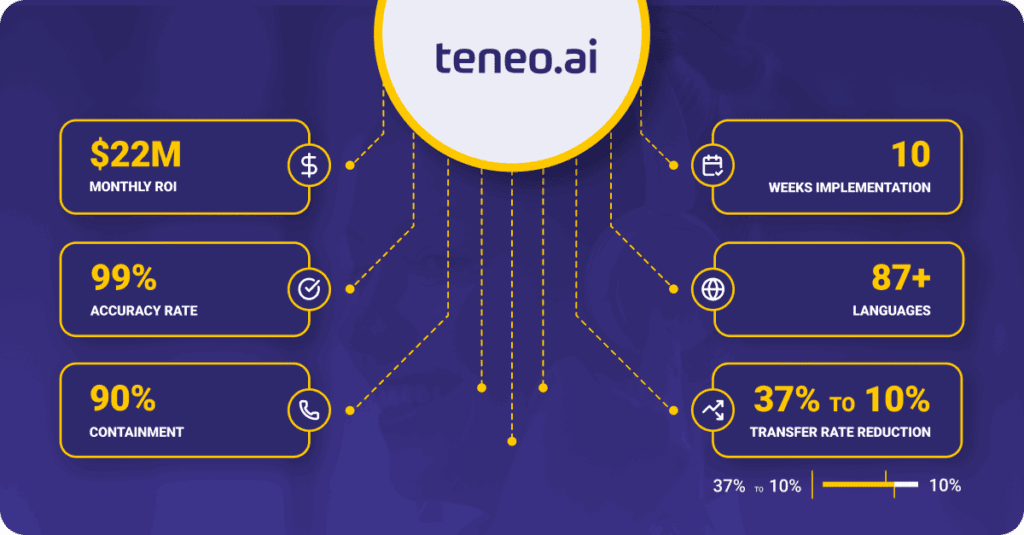The contact center automation landscape is experiencing a seismic shift. As we move deeper into 2025, agentic AI has emerged as the transformative force reshaping how enterprises deliver customer service. Unlike traditional automation that follows pre-programmed scripts, agentic AI agents can reason, decide, and act autonomously in real-time conversations, particularly in voice interactions where the stakes are highest.
What is Agentic AI and Why Voice-First Matters
Agentic AI represents the next evolution beyond conversational AI. While chatbots and traditional voice assistants respond to specific commands, agentic AI agents operate with true autonomy. They understand context, make decisions, and take actions without human intervention—all while maintaining the natural flow of conversation that customers expect.
The voice-first approach is crucial because phone interactions remain the primary channel for complex customer service issues. Despite the rise of digital channels, 68% of customer service interactions will be managed by agentic AI by 2028, with voice leading this transformation due to its immediacy and personal nature.
The Enterprise Imperative: From Pilot Programs to Production Scale
The market data is compelling. The agentic AI market is projected to explode from $5.2 billion in 2024 to $196.6 billion by 2034—a staggering 43.8% compound annual growth rate. More importantly, 33% of enterprise software applications will incorporate agentic AI by 2028, signaling a fundamental shift from experimental deployments to mission-critical implementations.
Enterprise AI budget allocation reflects this urgency. In 2025, organizations are expected to allocate 18% of their digital technology budgets to AI, compared to 14% in 2024. This represents a fundamental shift from innovation budgets to core operational spending, indicating that AI has moved from experimental to essential.
This isn’t about replacing human agents—it’s about creating a new paradigm where AI handles routine inquiries with superhuman efficiency while human agents focus on complex, high-value interactions that require empathy and creative problem-solving.

Real-World Success: The $22M Monthly ROI Case Study
While many companies are still running pilot programs, industry leaders are already seeing transformative results at scale.
A recent case study from a global technology company demonstrates the extraordinary potential of voice-first agentic AI implementation.
This Magnificent 7 technology leader—one of the world’s largest software companies—achieved remarkable results in just 10 weeks:
- $22 million monthly ROI from AI agent implementation
- 99% accuracy rate in voice interactions
- 90% call containment with autonomous resolution
- 7 million monthly customer interactions transformed
- 42 languages supported through advanced LLM technology
- Transfer rates reduced from 37% to under 10%
The Challenge: When Traditional Systems Fail
The company’s previous automated voice system was routing calls to the wrong agents and failing to understand customer intent. Operational costs were increasing while customers became frustrated with long wait times and unresolved issues. The problematic system required seven months just to address core issues, creating an unacceptable experience for a global technology leader.
The Solution: Lightning-Fast Transformation
The decision to implement Teneo AI Agent proved transformative. The 10-week deployment handled complex customer inquiries across order management, technical support, billing, and account services. The rapid deployment delivered immediate ROI with human-like conversation capabilities that exceeded all performance expectations.
Key Implementation Highlights
- Complete transformation in 10 weeks vs. seven months of previous system fixes
- Auto-translation implementation required only 5 days for global deployment
- 55% of callers referred to web resources, saving agent time
- Enhanced agent performance through AI-collected customer information
The Production-Scale Advantage: Real Results vs. Pilot Programs
The case study exemplifies a broader trend: while many companies are still running pilot programs, industry leaders are already seeing transformative results at scale. Consider these real-world outcomes from enterprises that have moved beyond experimentation:
- 60% call containment rates with autonomous resolution
- $32.4 million in monthly cost savings across customer portfolios
- 99% resolution accuracy in voice interactions
- 18% improvement in customer satisfaction scores
The key differentiator isn’t just the technology—it’s the proven ability to operate at enterprise scale. With over 17,000 AI agents currently in production handling millions of interactions monthly, the most advanced platforms demonstrate that agentic AI isn’t a future concept—it’s a present reality delivering measurable ROI.
Additional Enterprise Success Stories
Beyond the $22M monthly ROI case study, other major implementations showcase the scalability of voice-first agentic AI:
- Telefónica: 74% improvement in resolution rates while saving millions annually
- HelloFresh: 6% boost in upsell revenue with 2-minute average handling time reduction
- Swisscom: 20% operational cost reduction with 18% customer satisfaction improvement
These results demonstrate that voice-first agentic AI delivers consistent value across industries and use cases.
Five Key Trends Shaping Contact Center Automation in 2026
1. Autonomous Decision-Making in Real-Time Conversations
Modern agentic AI goes beyond scripted responses. These systems analyze customer intent, access relevant data across multiple systems, and make decisions in real-time. For example, an AI agent can automatically process a refund, update account information, and schedule a follow-up call—all within a single conversation.
The global technology company case study demonstrates this capability: their AI agents handle complex inquiries across order management, technical support, billing, and account services with 99% accuracy while maintaining natural conversation flow.
2. Proactive Customer Engagement
Advanced AI agents don’t just respond—they anticipate. By analyzing customer behavior patterns and historical data, these systems can proactively reach out to customers before issues escalate. This shift from reactive to proactive service is transforming customer relationships.
3. Seamless Human-AI Collaboration
The future isn’t about replacing human agents—it’s about creating seamless collaboration. AI handles routine inquiries and data gathering, then seamlessly transfers complex cases to human agents with full context and recommended solutions. This approach improves both efficiency and job satisfaction.
As demonstrated in the case study, enhanced agent performance results when AI agents collect customer information and present it to live agents, minimizing the need for customers to repeat themselves.
4. Voice-Specific Optimization
While many platforms treat voice as an afterthought, leading solutions are purpose-built for voice-first experiences. This includes advanced speech recognition, natural language understanding optimized for spoken language, and response generation that sounds natural in conversation.
The additional 42-language capability achieved in just 5 days of auto-translation implementation showcases how voice-first platforms can rapidly scale globally while maintaining consistent performance.
5. Enterprise-Grade Security and Compliance
As AI handles more sensitive customer interactions, security and compliance become paramount. Leading platforms offer bank-grade security with comprehensive compliance certifications including GDPR, SOC 2, ISO 27001, and HIPAA—essential for regulated industries.
The Genesys Cloud Advantage: Enhancing Existing Investments
For organizations already invested in contact center platforms like Genesys Cloud, the question isn’t whether to adopt agentic AI—it’s how to enhance existing investments rather than replace them. The most successful implementations act as “voice AI accelerators” that supercharge existing platforms with advanced AI capabilities.
This approach offers several advantages:
- Preserve existing investments in contact center infrastructure
- Maintain operational control within familiar platforms
- Accelerate deployment through proven integrations
- Reduce risk by enhancing rather than replacing core systems
Organizations using this approach report faster implementation times, higher adoption rates, and better ROI compared to complete platform replacements.
Measuring Success: KPIs That Matter in 2026
As agentic AI moves from experimental to operational, measurement becomes crucial. The most important metrics include:
Operational Efficiency
- Call containment rates (target: 60%+, achieved: 90% in case study)
- Average handling time reduction
- First-call resolution improvement
- Agent productivity gains
Customer Experience
- Customer satisfaction scores (achieved: 18% improvement)
- Net Promoter Score improvements
- Customer effort score reductions
- Complaint resolution time
Business Impact
- Cost per interaction reduction (achieved: $5.60 per call)
- Revenue per customer improvements
- Operational cost savings (achieved: $22M monthly)
- Return on AI investment
Quality Metrics
- Resolution accuracy rates (achieved: 99%)
- Escalation rates to human agents (reduced from 37% to 10%)
- Compliance adherence
- Security incident rates
Implementation Best Practices: From Strategy to Scale
Start with Voice-Heavy Use Cases
Begin with scenarios where voice interactions are already common and complex enough to benefit from AI assistance. The global technology company case study focused on:
- Order management inquiries
- Technical support for complex issues
- Billing and account services
- Multi-language customer support
Ensure Enterprise Readiness
Before scaling, verify that your chosen platform meets enterprise requirements:
- Security certifications for your industry
- Integration capabilities with existing systems
- Scalability to handle peak volumes (7M+ monthly interactions)
- Compliance features for regulatory requirements
Plan for Human-AI Collaboration
Design workflows that optimize both AI efficiency and human expertise:
- Clear escalation triggers for complex cases
- Context preservation during handoffs
- Continuous learning from human agent interactions
- Performance monitoring and optimization
The case study demonstrates this approach: AI agents collect information and present it to human agents when escalation is needed, creating seamless collaboration.
The Competitive Landscape: Choosing the Right Platform
The agentic AI market is rapidly evolving, with new players emerging regularly. However, enterprise buyers should focus on platforms that demonstrate:
Proven Scale
Look for platforms with thousands of AI agents in production, not just pilot programs. Scale demonstrates both technical capability and enterprise readiness. The 17,000+ AI agents in production across various implementations provide this proof.
Voice-First Design
Many platforms treat voice as secondary to text-based interactions. Choose solutions purpose-built for voice-first experiences with proven accuracy in spoken conversations—like the 99% accuracy achieved in voice interactions.
Enterprise Integration
Seamless integration with existing contact center platforms, CRM systems, and business applications is essential for rapid deployment and adoption. The 10-week implementation timeline demonstrates this capability.
Regulatory Compliance
Comprehensive security and compliance certifications are non-negotiable for enterprise deployments, especially in regulated industries.
Looking Ahead: The Future of Customer Service
As we look toward the remainder of 2025 and beyond, several trends will shape the evolution of contact center automation:
Increased Autonomy
AI agents will handle increasingly complex scenarios, making decisions that currently require human judgment while maintaining appropriate oversight and controls.
Industry Specialization
Agentic AI platforms will develop industry-specific capabilities, understanding the unique requirements and regulations of sectors like healthcare, financial services, and telecommunications.
Predictive Service
AI will shift from reactive to predictive, identifying and resolving issues before customers even realize they exist.
Emotional Intelligence
Advanced AI will better understand and respond to customer emotions, providing more empathetic and effective service.
Conclusion: The Time for Action is Now
The agentic AI revolution in contact center automation isn’t coming—it’s here. The $22 million monthly ROI achieved by a global technology leader in just 10 weeks demonstrates that organizations can gain significant competitive advantages in customer service efficiency, cost reduction, and customer satisfaction.
The key is choosing a platform that offers proven scale, voice-first design, enterprise integration, and regulatory compliance. With the right approach, organizations can transform their contact centers from cost centers into competitive advantages that drive customer loyalty and business growth.
The question isn’t whether agentic AI will transform customer service—it’s whether your organization will lead or follow in this transformation. The companies that act decisively today will set the standard for customer service excellence in the agentic AI era.
Ready to explore how voice-first agentic AI can transform your contact center?
Learn more about proven solutions already delivering results at enterprise scale, explore our comprehensive learning hub for additional insights and case studies, or contact us to enhance your automation capabilities.




